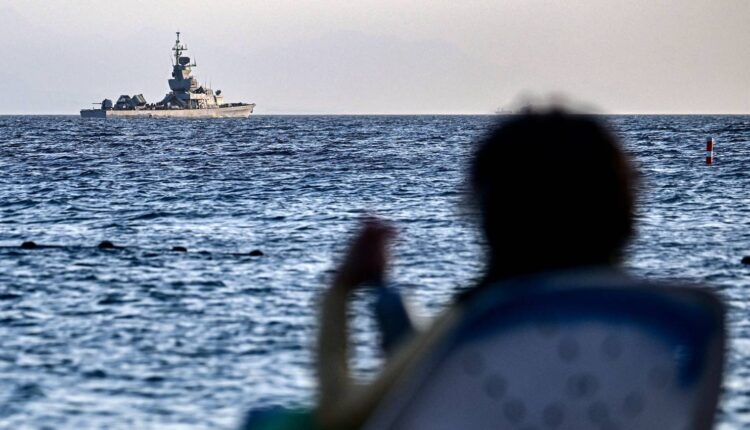North Red Sea attacks… A new “high-risk” area tightens the noose on shipping linked to Israel
Shipping traffic linked to Israel has suffered a new blow in the Red Sea after the Yemeni armed forces expanded the high-risk area for these ships through what has become clear to be a new escalation path launched with two qualitative operations targeting two Israeli-linked vessels off the coasts of “Yanbu” and “Jeddah” in Saudi Arabia, which forced the maritime security sector to reconsider its assessments of the risks of the Red Sea for these ships.
Derar Al-Tayeb, Al-Khabar Al-Yemeni:
In recent weeks, “Ansar Allah” leader Abdul-Malik Al-Houthi had referred to the implementation of naval operations in the far north of the Red Sea, the details of which were not disclosed by the Yemeni armed forces. However, last Monday, it was announced that the “Scarlet Ray” owned by Israeli businessman Idan Ofer, had been targeted by a ballistic missile that achieved a precise hit, which came as a surprise given the ship’s location off “Yanbu,” Saudi Arabia, in the northern Red Sea. The impact of this surprise was compounded by another attack targeting the “MSC Abi” off Jeddah the following day.
Prior to these attacks, maritime security and insurance companies had identified the southern Red Sea (off the western coast of Yemen and up to Bab Al-Mandeb and the Gulf of Aden) as a high-risk area for ships on the Yemeni target list, given that most of the destructive attacks were concentrated in this area. This has led to repeated increases in insurance premiums for these ships, reaching 2% of the ship’s value for each crossing of this area last year.
Although previous attacks by the Yemeni armed forces have not been strictly confined to this area, with operations carried out in the Arabian Sea and even in the Indian Ocean, as well as joint operations with the Iraqi resistance in the Mediterranean, the targeting of the “Scarlet Ray” caused a particular and surprising shock as it was seen as an “expansion of the scope of operations,” according to Lars Jensen, former executive at “Maersk” and CEO of the consulting firm “Vespucci Maritime.” It was also considered “the furthest attack north of the Red Sea,” according to the Combined Maritime Forces (CMF) Joint Information Center, which this week reminded shipping companies that “the Houthis have the capability to target commercial vessels deep into the Red Sea and Gulf of Aden,” according to the center’s latest memo.
To explain why the new attacks are seen as a new escalation, British risk management company “Dryad Global” stated today that “the northern part of the Red Sea was considered a less dangerous transit route compared to Bab Al-Mandeb and the southern passage, but the attack on the “Scarlet Ray” ship confirms the expansion of the scope of Houthi operations,“ noting that ”the consequences of this are profound,” including that “ships belonging to Israel are now almost completely excluded from safe passage through the Red Sea.”
This comment suggests that the accuracy of the strike was an important factor in assessing the attack, as the previous risk assessment appears to have been based on the assumption that it would be difficult to carry out accurate and destructive attacks in that area and perhaps other assumptions regarding the destinations of the violating ships passing through that area. The targets of the new attacks suggest that these ships are primarily bound for Saudi Arabia, which would place the previous danger zone, “the southern Red Sea,” outside the flight path in the first place, as ships return from the ports of Jeddah and Yanbu directly to the Suez Canal.
This raises the question of whether the armed forces have used a new weapon to expand the area of precision targeting—and not just the scope of the threat—of ships associated with Israel. However, pending an answer to this question, it is clear that the Yemeni armed forces have taken the decision to target violating ships passing through the northern Red Sea region. The attack on the “MSC Abi” off Jeddah on Tuesday represented a clear answer to questions from the maritime security sector, including the British risk management company “Vanguard,” about whether this was part of a broader escalation strategy or whether the previous ship was simply an isolated incident. The use of a combination of missiles and drones in the second operation revealed a clear insistence to hit the ship and not just threaten it.
When the Yemeni armed forces recently announced the fourth phase of the blockade, some maritime security experts commented that this would not change much, given that most companies dealing with Israeli ports already avoid Bab Al-Mandeb. But what about the other side of the Red Sea?
The British magazine Lloyd’s List, which specializes in maritime affairs, says that the attack on the Scarlet Ray ship highlights the dangers of the northern Red Sea. This indicates that the maritime security sector is looking at a new risk area that is forming quickly. Crossing this area will likely result in high insurance premiums. Conditions are similar to those imposed by the Joint War Committee (a committee representing the marine insurance markets in London) regarding transit through the southern Red Sea. According to these conditions, risk insurance premiums for transit through this area must be paid separately before the voyage if the insurance company agrees. If the insurance company does not agree, the ship operators will bear the full losses, as happened with the Eternity C ship.”
As mentioned by Dryad Global, this will ultimately result in all ships with any links to Israel or companies dealing with Israeli ports staying away from the entire Red Sea, which reinforces the reality of the Yemeni armed forces’ control over the waterway and rebalances maritime security in the region on the balance of Yemeni sanctions imposed on Israel, which is a huge geopolitical and strategic change based on the fact of the defeat of the US Navy against Sana’a.

